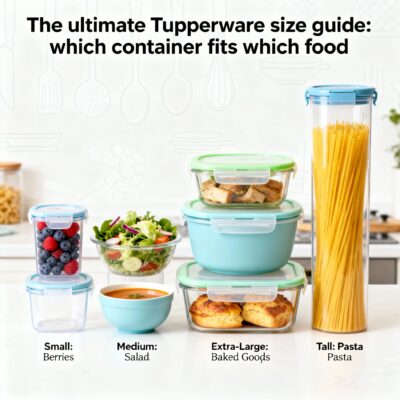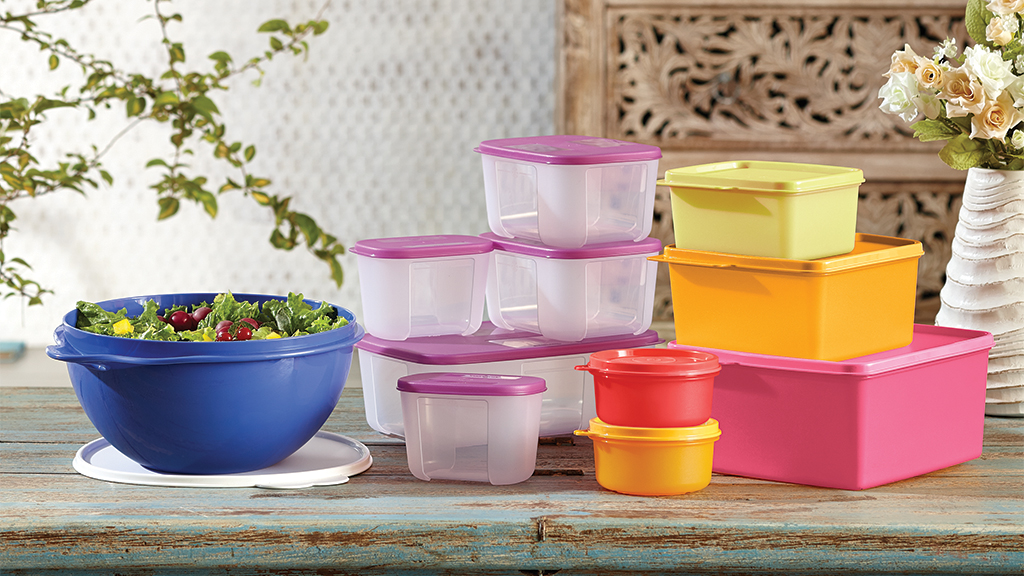Use 1–2 cup containers for dips, snacks, herbs, and leftovers sides; 3–5 cups for full meals, salads, pasta, and cut fruit; 6–12 cups for family portions, bulk produce, and baked goods. Choose shallow for sandwiches and brownies, tall for soups, grains, and leafy greens.
The ultimate Tupperware size guide: which container fits which food (with printable chart)
Why size matters
Right-size containers keep food fresher, stop sogginess, and save space. Too big means excess air and faster spoilage. Too small means squishing and leaks. Think portion, shape, and storage spot before you grab a lid.
Quick sizing rules
-
Match volume to the food’s actual portion with minimal headspace.
-
Use shallow containers for flat foods and crisp items.
-
Use tall containers for liquids, grains, and leafy greens.
-
Round shapes are better for soups and stews. Rectangles maximize shelf space.
-
Leave a little headspace for hot foods and all freezer items.
Printable size chart
Use this one-page chart as your kitchen reference. Print in landscape for best readability.
| Common Size | Metric (approx) | Best For | Shape Tips | Fridge/Freezer/Pantry |
|---|---|---|---|---|
| 0.5 cup | 120 ml | Dips, dressing, nuts, seeds | Small round | Lunchbox, pantry |
| 1 cup | 240 ml | Hummus, yogurt, cut veggies, baby food | Small round/rect | Lunchbox, fridge |
| 1.5 cups | 350 ml | Salsa, berries, leftover sides | Shallow round | Fridge |
| 2 cups | 475 ml | Rice portions, oats, cut fruit, trail mix | Round/rect | Fridge, pantry |
| 3 cups | 700 ml | Pasta, quinoa, small salads, curry | Rect preferred | Fridge |
| 4 cups | 950 ml | Meal-sized leftovers, roasted veg | Rect/shallow | Fridge, freezer |
| 5 cups | 1.2 L | Big salads, stir-fries, chicken pieces | Tall rect | Fridge |
| 6 cups | 1.4 L | Soup, chili, family sides | Tall round | Fridge, freezer |
| 7–8 cups | 1.6–1.9 L | Whole lettuce hearts, corn cobs, baked goods | Tall for greens, shallow for bakes | Fridge, pantry |
| 9–10 cups | 2.1–2.4 L | Bread loaves, sheet bakes, bulk berries | Shallow wide | Fridge, freezer |
| 12–14 cups | 2.8–3.3 L | Batch-cooked stews, stock, large salads | Tall round | Freezer |
| 16–18 cups | 3.8–4.3 L | Meal prep for the week, big produce | Rect tub | Fridge, freezer |
| 20–24 cups | 4.7–5.7 L | Party salads, marinating, bakery storage | Wide rect | Fridge |
| Modular slim | 1–2 L | Spaghetti, soba, breadsticks | Tall narrow | Pantry |
| Modular medium | 2–3 L | Rice, lentils, beans, sugar | Rect stack | Pantry |
| Modular large | 3–5 L | Flour, oats, cereal | Rect stack | Pantry |
By food type
-
Fruits and veg: Berries 1–2 cups; cut melon 4–6 cups; leafy greens 6–8 cups with paper towel; herbs 0.5–1 cup with a dab of water.
-
Proteins: Grilled chicken 3–4 cups; steak strips 3 cups; raw cuts 4–6 cups with drip tray; marinating 8–12 cups.
-
Grains and pasta: Cooked rice 2 cups per portion; cooked pasta 3–4 cups for a meal; dry pasta 2–3 L modular.
-
Baked goods: Brownies/cookies 7–10 cups shallow; bread loaf 9–12 cups; muffins 6–8 cups.
-
Liquids: Broth 4–6 cups; soups/chili 6–12 cups; sauces 0.5–1.5 cups.
Fridge picks
-
Leftover dinners: 4–6 cups rectangles stack best.
-
Salad kits: 5–8 cups tall with a dry layer on top.
-
Sandwiches and wraps: 3–4 cups shallow to avoid squish.
-
Cut fruit: 2–4 cups with a paper towel to catch moisture.
Freezer picks
-
Soups, stews, curries: 6–12 cups; leave 1–2 cm headspace.
-
Prepped proteins: 3–5 cups, flatten for quick thaw.
-
Smoothie packs: 2 cups; portion per serving.
-
Bread and bakes: 8–12 cups shallow to prevent crushing.
Pantry picks (dry goods)
-
Flour: 3–5 L for 2–5 lb bags.
-
Sugar: 2–3 L for 2–4 lb.
-
Rice/beans/lentils: 2–3 L per 2–3 lb.
-
Cereal and oats: 3–4 L to keep crisp.
-
Pasta: 1–2 L slim for long shapes; 2–3 L for short shapes.
Shape matters
-
Shallow vs tall: Shallow keeps delicate foods intact and crispy. Tall suits liquids and leafy items.
-
Round vs rectangle: Round stirs and pours better. Rectangles maximize shelf space and stack like bricks.
Portion guide
-
Kids snacks: 0.5–1 cup.
-
Sides: 1–2 cups.
-
Mains: 3–4 cups.
-
Family share: 6–8 cups.
-
Batch cooking: 10–14 cups.
How to size what you own
-
Fill-and-measure: Fill with water, pour into a measuring jug to get volume.
-
Fit test: Place the food in a bowl first, then transfer to a matched container.
-
Headspace check: For freezing, leave about 10% empty.
-
Label habit: Note volume on the base with removable tape.
Freshness tips
-
Paper towel trick: Line for berries and greens to reduce moisture.
-
Venting: Crack the lid for steamy foods until cooled.
-
Layering: Wet foods at the bottom, crisp items on top.
-
First in, first out: Store newer items behind older ones.
Care and stacking
-
Cool before sealing to avoid condensation.
-
Keep tomato sauces in stain-resistant containers.
-
Stack by footprint: same-base sizes nest and save space.
-
Replace warped lids to prevent leaks.
Quick combos that always work
-
Overnight oats: 1–2 cups.
-
Lunch salads with toppings: 4–5 cups.
-
Family pasta night leftovers: 6–8 cups.
-
Bake and store brownies: 8–10 cups shallow.
-
Weekly chopped veg kit: 8–12 cups tall.
FAQ
-
Can I microwave it? Vent the lid and use medium power. Stir halfway for even heating.
-
How much headspace for freezing? Leave about 1–2 cm or roughly 10% of volume.
-
Best for meal prep? 3–5 cups for single meals, 6–8 cups for shared dishes.



